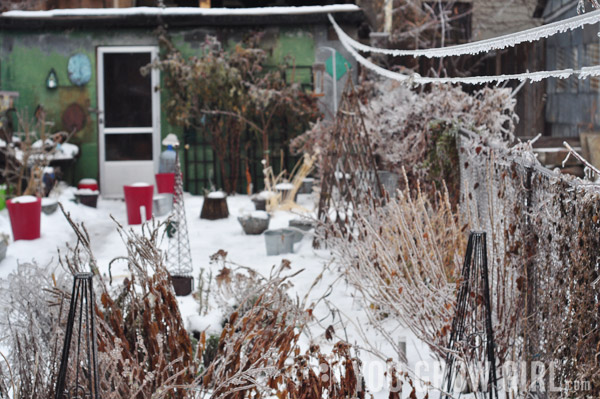
Two nights ago Toronto was hit with an ice storm. Anything that didn’t move during the night was encased inside a thick, vitreous ice. Trees, bushes, leaves, grasses, clotheslines, metal structures, fences, birdhouses, empty planters… they were all turned into crystalline sculptures. I have never experienced this phenomenon as a gardener, and I am equally fascinated as I am worried about how this bodes for some of the plants in my garden.
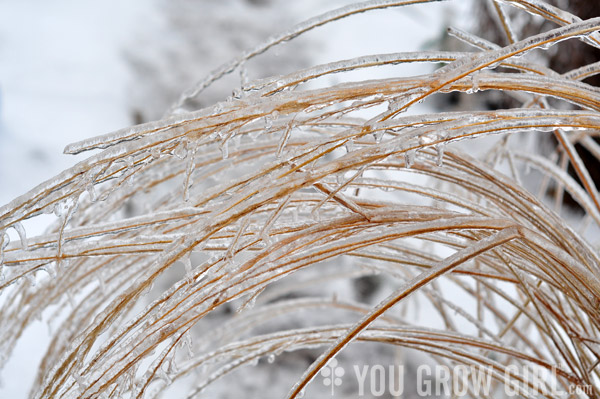
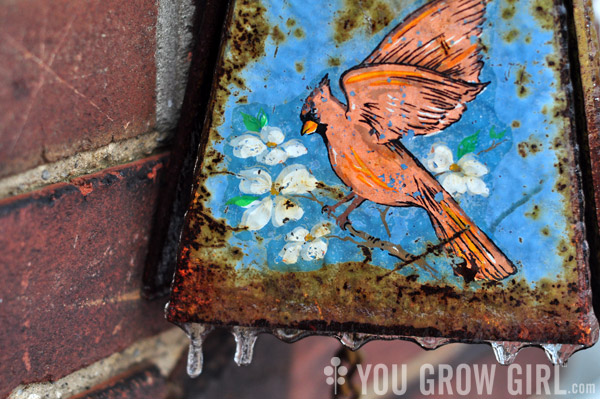
A vintage bell (with bird decals) that hangs outside the back door.
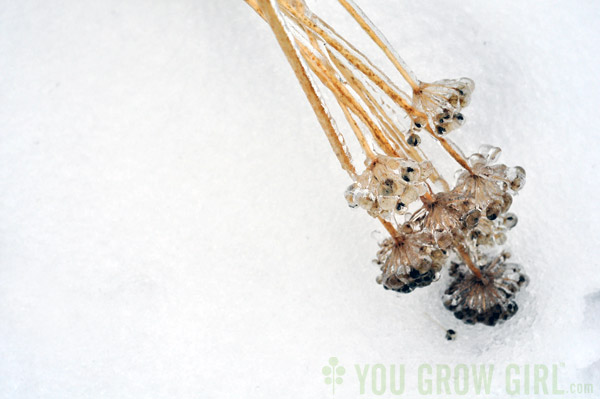
Frozen garlic chive (Allium tuberosum) seedpods.
A quick tour shows that most of the frozen plant parts are seedpods and stems that would have been cut back in the spring. I have no worries or concerns for those plants and even the bushes and trees are tough as nails. I assume they will be fine as long as they are given the chance to thaw slowly, and do not crack or break under the weight of the ice.
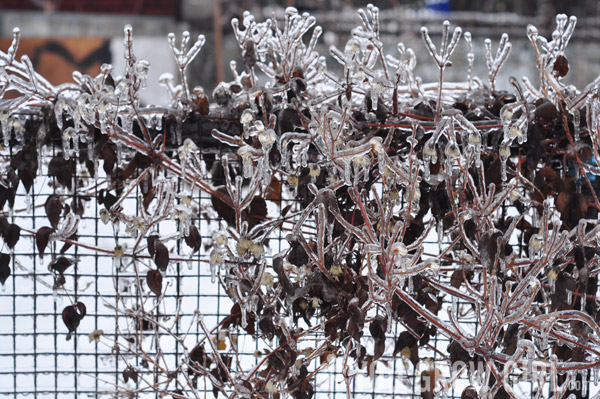
I no longer recall if this is Sweet Autumn clematis (Clematis terniflora) or Clematis virginiana. Regardless, I am not concerned as this is a tough, fast-growing vine. It blooms (vigorously I might add) from new growth and is pruned in the spring, so whatever damage has happened here should not effect its future.
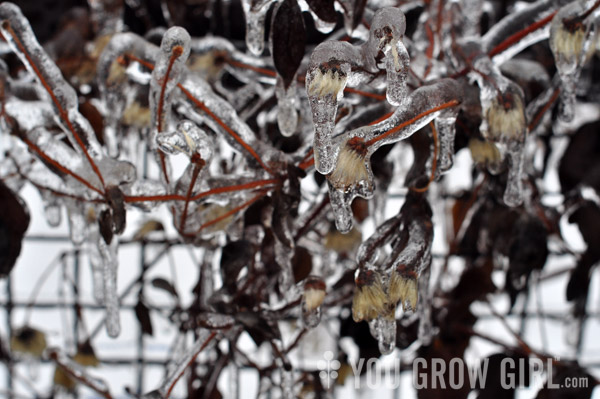
A close-up of the same clematis.
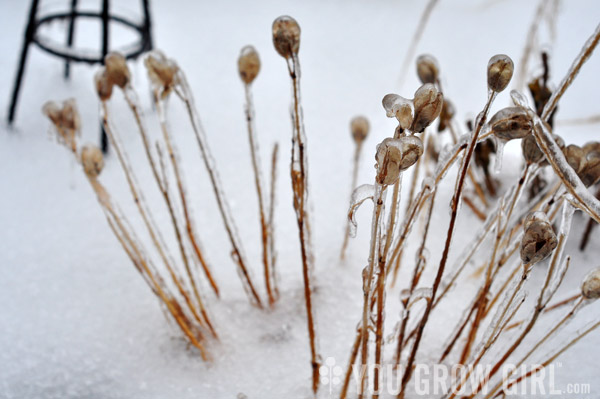
Frozen iris seedpods.
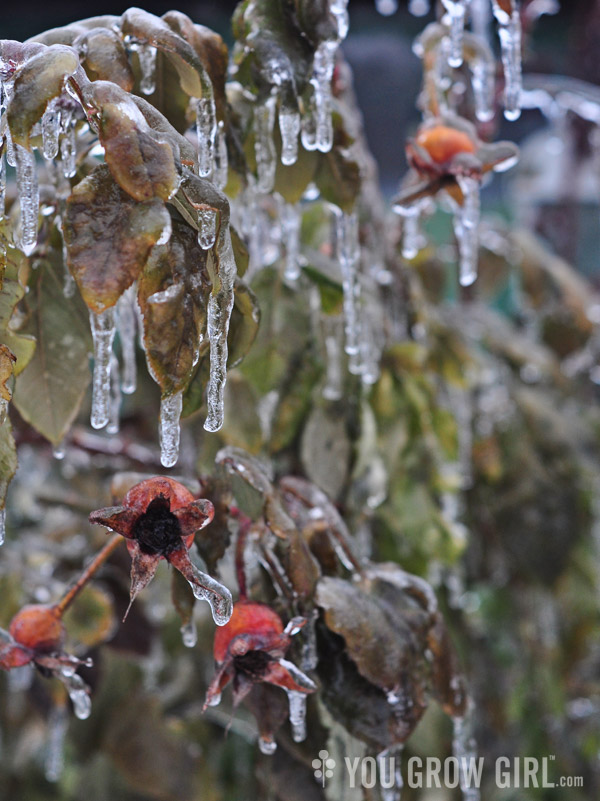
My massive, climbing ‘Westerland’ rose. I pruned it lightly this fall and regret now that I didn’t cut it back harder. It’s a tough plant, but I am concerned about the damage that may be caused by the weight of the ice on its long stems.
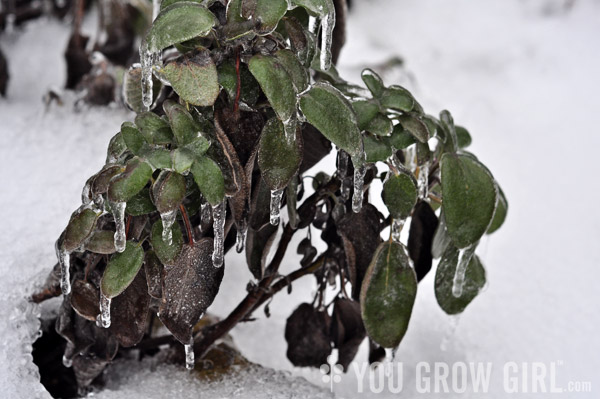
My real concerns lie with tender(ish) plants that prefer a drier winter such as lavender, salvias, and the woodier thymes (Portuguese Thyme (Thymus carnosus) and Citrus Thyme (Thymus x citriodorus)). I have several types of all three and would like them to live, especially since they are all going into their fourth spring and have only just reached their peak. They have become beautiful (and productive) little herbal bushes and I am not keen on the idea that I may need to start over again with teeny transplants.
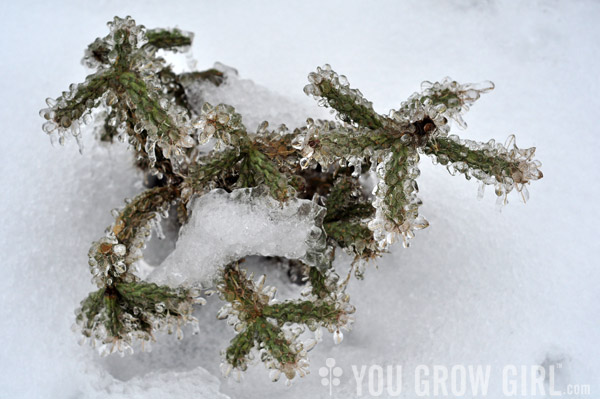
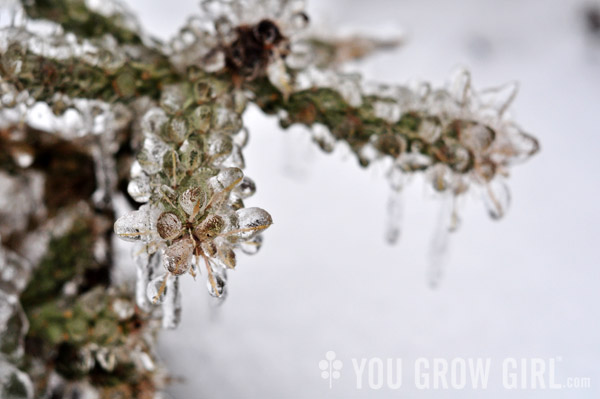
Sante Fe cholla (Cylindropuntia vindiflora)
I am also worrying my hands about the hardy cacti that live in the Dry Bed. Some have been in the ground for only 1 or 2 seasons and I have been very excited about the coming spring/summer show of colourful flowers. Others have been in my care for quite some time and there is a personal attachment. I would hate to lose them. Of course, there is always the chance that I won’t, but since I’ve never been through this with them, I don’t know what to expect.
As I said above, the curious gardener in me is excited about this event and the opportunity to observe first-hand how it will play out in the garden, but the plant lover in me is mentally steeling for the possibility of loss.
p.s. My focus here was on the garden, but we were lucky in that we did not suffer any damage due to fallen trees and wires. I am extremely grateful that we continue to have heat and power. Many others in Toronto still do not.
Fantastic tho scary photos.
We have had some lavender survive down to -20c here in Central France so they could well be OK. My thyme (common and lemon) has survived up to -9c also.
Our garden has only this week come out of a blanket of snow that has laid for the last 5 weeks after an early snowfall in mid November. So busy doing tidy up jobs I should have done weeks ago.
The weather really does test us gardeners!
We’ve already gone below -9C this winter (tonight’s low is -14C), although I don’t think we have hit -20C yet.
Your picture are beautiful..
I live about 20 mins. south of Yosemite National park, Ca.
The week before we also got snow(about 4 inch) with a very cold Arctic type of air that came through here..
Our snow lasted over a week, which is longer then usual.
I would think your plants will all come back when it warms up in the spring time.
My son lives allot lower in elevation then I do, but in the last few years, he has gotten more snow then I do!..It is all very strange!.
He has a HUGE Pinkish flowering Cactus at his house.
When spring comes that Cactus flowers with such vigor , nobody can believe it..Friends that live in the desert are even amazed.
I might add, it flowers more then once a year.
So I have faith your Cactus will be better then ever..
Give it a chance..
Happy & Healthy Holidays to everyone,
Annie.
The snow hasn’t been a problem. The soil in that bed is sandy so while there have been some issues with rust developing in previous years, the plants have all bounced back beautifully. My fear is in what sort of tissue damage could result from being encased inside ice like that. I guess I’m going to find out!
The ice is so dramatic and beautiful, but I hope that it doesn’t cause any damage to your plants. Glad you’ve escaped power loss and other problems. We’re in the grip of a storm here in the UK at the moment, but nothing as big as yours. Strong winds, power loss in some place and some flooding. Hope you stay warm, and have a lovely Christmas and a very happy New Year.
There were supposed to be more problems with power yesterday, but we’re lucky that it didn’t get to be as windy as it was supposed to. The sound of the icy trees swaying in the windy is frightening. Cheers!
In Cincinnati, while our average temps aren’t as low as yours, we get at least one ice storm a year. My succulents always do just fine, including a hardy cactus. The same for my rosemary. The worst of the damage is the potential breakage. Fun fact, which may be comforting. Citrus growers will intentionally ice-coat their plants in cold waves to protect them. The ice is less damaging than the frost, forming a natural insulation.
That is a fun fact! I lost a few of my potted citrus in my first year in the house when the unheated porch froze unexpectedly. It was sad to lose them but I did learn which types are tougher than others.
I thought that looked like cholla! The only real danger is of parts breaking off under the weight of the ice. Cholla is pretty indestructible. The extended -10 to -20 snap we had her a couple years back killed lots of things, but not the cholla. Merry Christmas from Santa Fe! Glad to hear you’re safe + have power.
Great to hear! The cholla is such an unknown to me since nobody grows this here. I am learning as I watch how it responds to different conditions.
Lovely pictures Gayla.
Dont worry about lavender, thyme and sage (or even roses).
Here in Denmark, we have this ice-glaze condition at least once every year, and these plants are truly happy here. Its actually the dry dessicating late winter winds (from Siberia) that will kill them, and particularly if they lack the protective cover of ice or snow. I hope you enjoy some lovely Christmas days, and my very best wishes for a wonderful New year.
Cheers
Emøke
Thanks so much for the reassurance. I can see how the glazing would act as an insulator. What worried me most was the potential for breakage that could lead to further damage down the road, but as of today everything looks fine. Happy Holidays!
Don’t worry too much about the ice. The mediterranean herbs in my garden survived very low temperatures (well, most of them, to be perfectly honest) and a ice-glaze. Here in Germany the wine growers even spray their plants with water to give them a protective coating with ice in times of very deep temperatures ! (Like the citrus trees mentioned above)
Have a wonderful Christmas and a Happy New Year !
Cheers
Joerg
I’ll just echo what Emøke and Emily said above. Ice is insulating and protective, not damaging — save, as you mentioned, the weight. It’s not just citrus farmers who will use it; fruit growers of all types have been known to ice over orchards and fields in hopes of saving their crops — even tender strawberries! Try not to worry too much. I’ll cross my “green thumbs” for a good outcome for you and yours.
Here, too. I was really worried about some of my young trees but they have bounced back so to speak. One lost branch and a pretty bad split. Nature’s resilience amazes me!
Your photographs are hauntingly beautiful – whilst it is a shame that the ice has encased your plants like that, it is reminiscent of an old abandoned cottage or something of the like.
I wish I could offer you the reassurance that other commenters have, but my wife is the green thumb in our relationship and we live in a climate where this has never occurred before (at least to my knowledge). I think you’ll be surprised at how hardy most of the plants in your garden are, however – most of them should bounce back pretty quickly when the weather fines up.
Good luck!